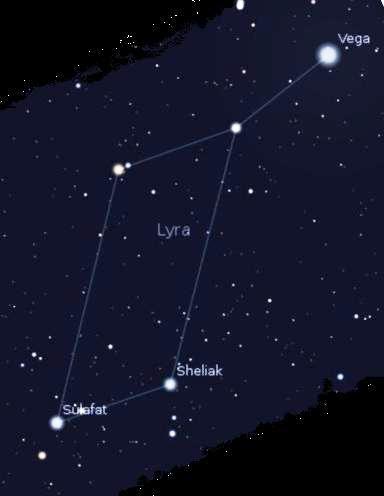| LOKI'S DAUGHTER | ||||
 |
 |
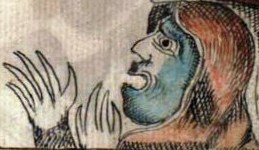 |
 |
 |
by Peter Krüger
©2013
[Germanic Astronomy]
We don't find much information about
Loki's daughter, Hel, in the northern sources. Most of it stems from
Gylfaginning. However, it might be enough to propose an astronomical
identification of her as a constellation. Let's look at the sources:
Gylfaginning 34 describes Loki's terrible children:
|
Enn átti Loki fleiri börn. Angrboða hét gýgr í Jötunheimum. Við henni gat Loki þrjú börn. Eitt var Fenrisúlfr, annat Jörmungandr, þat er Miðgarðsormr, þriðja er Hel. En er goðin vissu til, at þessi þrjú systkin fæddust upp í Jötunheimum, ok goðin rökðu til spádóma, at af systkinum þessum myndi þeim mikit mein ok óhapp standa, ok þótti öllum mikils ills af væni, fyrst af móðerni ok enn verra af faðerni, þá sendi Alföðr til goðin at taka börnin ok færa sér. Ok er þau kómu til hans, þá kastaði hann orminum í inn djúpa sæ, er liggr um öll lönd, ok óx sá ormr svá, at hann liggr í miðju hafinu of öll lönd ok bítr í sporð sér.
Hel kastaði hann í Niflheim ok gaf henni vald yfir níu heimum, at hon skyldi skipta öllum vistum með þeim, er til hennar váru sendir, en þat eru sóttdauðir menn ok ellidauðir. Hon á þar mikla bólstaði, ok eru garðar hennar forkunnarhávir ok grindr stórar. Éljúðnir heitir salr hennar, Hungr diskr hennar, Sultr knífr hennar, Ganglati þrællinn, Ganglöt ambátt, Fallandaforað þresköldr hennar, er inn gengr, Kör sæing, Blíkjandaböl ársali hennar. Hon er blá hálf, en hálf með hörundarlit. Því er hon auðkennd ok heldr gnúpleit ok grimmlig. |
XXXIV.
Yet more children had Loki. Angrboda was the name of a certain
giantess in Jötunheim, with whom Loki gat three children: one
was Fenris-Wolf, the second Jörmungandr--that is the Midgard
Serpent,--the third is Hel. But when the gods learned that this
kindred was nourished in Jötunheim, and when the gods perceived
by prophecy that from this kindred great misfortune should
befall them; and since it seemed to all that there was great
prospect of ill--(first from the mother's blood, and yet worse
from the father's)-then Allfather sent gods thither to take the
children and bring them to him. When they came to him,
straightway he cast the serpent into the deep sea, where he lies
about all the land; and this serpent grew so greatly that he
lies in the midst of the ocean encompassing all the land, and
bites upon his own tail. Hel he cast into Niflheim, and gave to her power over nine worlds, to apportion all abodes among those that were sent to her: that is, men dead of sickness or of old age. She has great possessions there; her walls are exceeding high and her gates great. Her hall is called Sleet-Cold; her dish, Hunger; Famine is her knife; Idler, her thrall; Sloven, her maidservant; Pit of Stumbling, her threshold, by which one enters; Disease, her bed; Gleaming Bale, her bed-hangings. She is half blue-black and half flesh-color (by which she is easily recognized), and very lowering and fierce. |
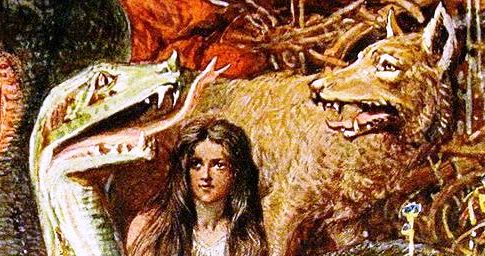 |
And in, Gylfaginning 50, Hermod makes a journey to Hel, on Frigg's behalf, in search of Baldur:
| En
þat er at segja frá Hermóði, at hann reið níu nætr dökkva dala
ok djúpa, svá at hann sá ekki, fyrr en hann kom til árinnar
Gjallar ok reið á Gjallarbrúna. Hon var þökð lýsigulli. Móðguðr er nefnd mær sú, er gætir brúarinnar. Hon spurði hann at nafni eða at ætt ok sagði, at inn fyrra dag riðu um brúna fimm fylki dauðra manna - "en eigi dynr brúin minnr undir einum þér, ok eigi hefir þú lit dauðra manna. Hví ríðr þú hér á helveg?" Hann svarar, at -"ek skal ríða til Heljar at leita Baldrs, eða hvárt hefir þú nakkvat sét Baldr á helvegi?" En hon sagði, at Baldr hafði þar riðit um Gjallarbrú, "en niðr ok norðr liggr helvegr." Þá reið Hermóðr, þar til er hann kom at helgrindum. Þá sté hann af hestinum |
L. "Now this is to be told
concerning Hermódr, that he rode nine nights through dark dales
and deep, so that he saw not before he was come to the river
Gjöll and rode onto the Gjöll-Bridge; which bridge is thatched
with glittering gold. Módgudr is the maiden called who guards the bridge; she asked him his name and race, saying that the day before there had ridden over the bridge five companies of dead men; but the bridge thunders no less under thee alone, and thou hast not the color of dead men. Why ridest thou hither on Hel-way?' He answered: 'I am appointed to ride to Hel to seek out Baldr. Hast thou perchance seen Baldr on Hel-way?' She said that Baldr had ridden there over Gjöll's Bridge,--'but down and north lieth Hel-way.' 'Then Hermódr rode on till he came to Hel-gate; he dismounted from his steed and made his girths fast, mounted and pricked him with his spurs; and the steed leaped so hard over the gate that he came nowise near to it. Then Hermódr rode home to the hall and dismounted from his steed, |
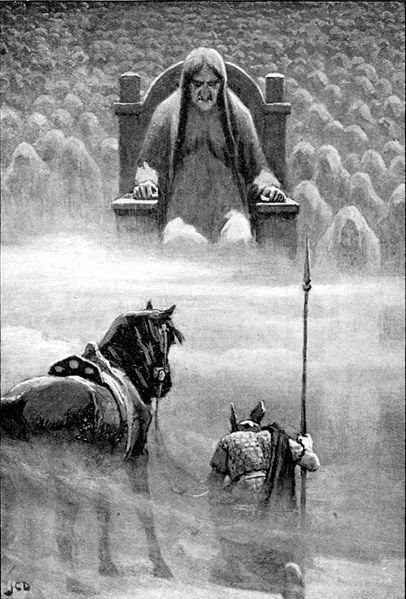 |
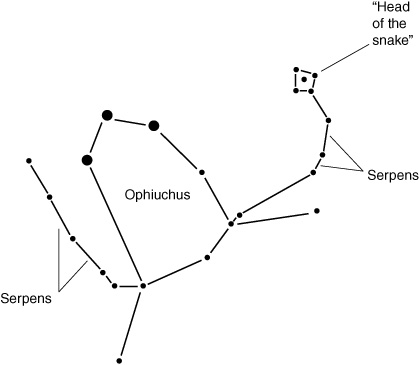
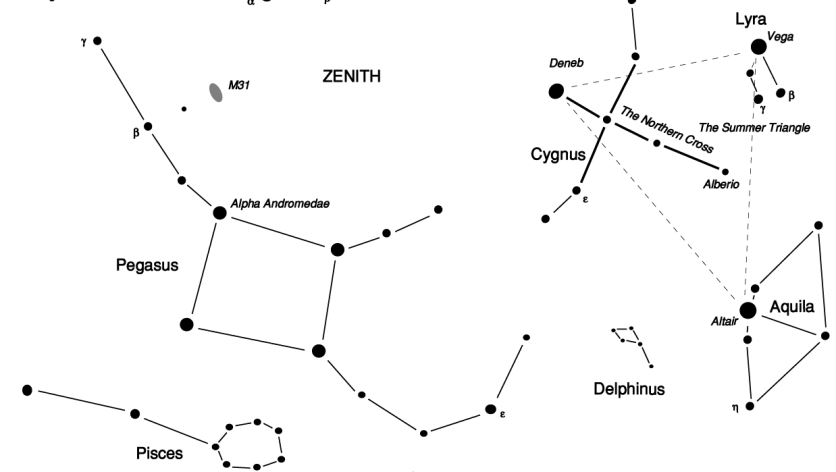
Indeed we find north of the helgate, Ophiuchus, a blue object: the bright bluish star Vega. Indeed this star seems to have been known in Iceland also as 'Blástjarnan'. I already identfied the pale-beaked raptor Nið-fölr with the constellation Lyra. This might explain why Hel is said to be half blue (Vega) and half flesh-colored (the other four stars of the vulture form the beak). Actually, the head of a vulture is not a bad fit considering that Hel is the goddess of death and disease.
